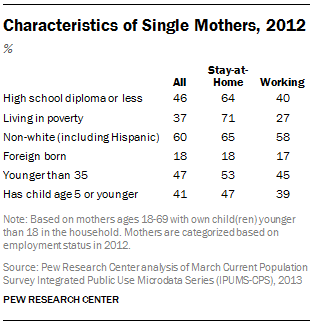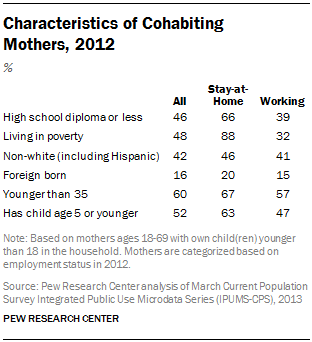From their education levels to their birthplaces, the nation’s 10.4 million stay-at-home mothers have distinct differences from the 25.2 million mothers who work outside the home. But there are equally striking differences among different groups of stay-at-home mothers, be they married, single or cohabiting.
In general, married stay-at-home mothers are better off financially than their counterparts who are single or cohabiting. They are more likely to say they are home because they choose to be, not because they could not find a job, or are ill, disabled or enrolled in school. They are better educated and less likely to be in poverty.
Married Mothers with Working Husbands
 About four-in-ten married stay-at-home mothers with working husbands (42%) have at most a high school diploma, compared with only a quarter (25%) of married working mothers. Only a third (32%) have a college education, compared with 47% of married working mothers. Married stay-at-home mothers with working husbands are more likely than their working counterparts to be poor, 15% compared with 3%.
About four-in-ten married stay-at-home mothers with working husbands (42%) have at most a high school diploma, compared with only a quarter (25%) of married working mothers. Only a third (32%) have a college education, compared with 47% of married working mothers. Married stay-at-home mothers with working husbands are more likely than their working counterparts to be poor, 15% compared with 3%.
As is true of stay-at-home mothers overall, those who are married with working husbands are younger than their working counterparts. A higher share has a child age 5 or younger at home. They are more likely to be Hispanic and less likely to be white. Married stay-at-home mothers with working husbands are nearly twice as likely to be foreign born as their working counterparts (38% vs. 20% in 2012), a larger gap than is true for other types of stay-at-home mothers compared with their working counterparts.
Married stay-at-home mothers with working husbands represent the largest group of stay-at-home mothers, 68% in 2012. That share has declined since 1970, when it was 85%. The number of these married stay-at-home mothers, 11.6 million in 1970, was 6.4 million in 2000 and 7.1 million in 2012.
The vast majority of married stay-at-home mothers with a working husband (85% in 2012) say they are not working because they are taking care of their home and family. The share was 96% in 1970. Small shares say they are home because they were ill or disabled (5%), were in school (4%) or could not find a job (3%).
Single Mothers
 Education levels of single stay-at-home mothers are markedly lower than those of single working mothers. About two-thirds (64%) have at most a high school diploma compared with 40% of single working mothers. Only 8% have at least a college degree, compared with 20% of single working mothers who do.
Education levels of single stay-at-home mothers are markedly lower than those of single working mothers. About two-thirds (64%) have at most a high school diploma compared with 40% of single working mothers. Only 8% have at least a college degree, compared with 20% of single working mothers who do.
Most (71% in 2012) are below the poverty level, compared with a quarter (27%) of single working mothers. One-in-five single stay-at-home mothers (20%) received welfare income in 2012, compared with only 4% of single working mothers. About a quarter (23%) received alimony or child support, compared with 30% of working single mothers who did. And 5% reported receiving some income from family or friends.
Single stay-at-home mothers are slightly younger than working single mothers, and are more likely to have at least one child age 5 or younger at home. About a third are white, somewhat less than the 42% of working single women who are, and about a third are black, somewhat more than the 29% of working single mothers who are. A quarter are Hispanic, a similar share as for working single mothers (23%). The share of foreign-born is similar for single stay-at-home mothers and working mothers but is lower than for married stay-at-home mothers.
The share of all stay-at-home mothers who are single rose to 29% in 1993, fell to 18% in 1999 and grew slightly to 20% in 2012.11 There were 1.1 million single stay-at-home mothers in 1970, 1.5 million in 2000 and 2 million in 2012.
Single stay-at-home mothers include those who have never been married, are divorced, separated or widowed, and who do not have partners living with them. About half (48%) have another adult relative in the household, an indication that someone else may be available to help with child care or financial support.
Less than half of single mothers at home (41% in 2012) say the reason they do not hold a paying job is to take care of home and family. The rest say say they are home because they are ill or disabled (27%), cannot find work (14%), or are in school (13%). The reasons for being home have changed substantially for this group since 1970, when 76% said they were at home in order to care for home and family.
Cohabiting Mothers
 As is true of single mothers, there is a wide education gap between cohabiting stay-at-home mothers and cohabiting working mothers. Two-thirds of cohabiting stay-at-home mothers (66%) have a high school diploma at most, compared with 39% of working cohabiting mothers. Only 5% have at least a college education, compared with 17% of cohabiting working mothers. Most are poor (88%), compared with a third (32%) of their working counterparts.
As is true of single mothers, there is a wide education gap between cohabiting stay-at-home mothers and cohabiting working mothers. Two-thirds of cohabiting stay-at-home mothers (66%) have a high school diploma at most, compared with 39% of working cohabiting mothers. Only 5% have at least a college education, compared with 17% of cohabiting working mothers. Most are poor (88%), compared with a third (32%) of their working counterparts.
Among cohabiting stay-at-home mothers, fully one-in-five (21%) is younger than 25, compared with 15% of working cohabiting mothers. Nearly two-thirds have at least one child age 5 or younger at home, compared with about half of cohabiting working mothers who do.
Cohabiting stay-at-home mothers are somewhat less likely than their working counterparts to be white, and somewhat more likely to be Hispanic. The shares of cohabiting stay-at-home mothers and at-work mothers who are black are identical. One-in-five cohabiting stay-at-home mothers (20%) is foreign born, somewhat higher than for cohabiting working mothers (15%) but lower than for married stay-at-home mothers (38%).
Data for cohabiting mothers have been fully available only since 2006, when they made up 4% of all stay-at-home mothers; their share was 5% in 2012.
About two-thirds of cohabiting stay-at-home mothers (64% in 2012) say they are taking care of home and family. Others say they are not working because they are ill or disabled (17%), going to school (11%) or unable to find work (6%).
Married Mothers with Non-Working Husbands
 In terms of education, more than half (58%) of married stay-at-home mothers whose husbands do not work have a high school diploma or less, markedly more than the 39% share for married working mothers with non-working husbands. Only 16% have graduated from college, compared with a third (34%) of their working counterparts.
In terms of education, more than half (58%) of married stay-at-home mothers whose husbands do not work have a high school diploma or less, markedly more than the 39% share for married working mothers with non-working husbands. Only 16% have graduated from college, compared with a third (34%) of their working counterparts.
About three-fourths (74%) are poor, compared with a quarter (24%) of their working counterparts. Among this group, 9% received welfare in 2012, compared with 4% of their working counterparts.
They are somewhat more likely to be Hispanic than comparable working mothers and less likely to be white. The share who are immigrants was 35% in 2012, compared with 31% of their working counterparts.
Married stay-at-home mothers whose husbands are not working made up 7% of all stay-at-home mothers in 2012. Since 1970, their share of stay-at-home mothers has ranged from 5% to 9%. They are younger than comparable working mothers: About four-in-ten (39%) are younger than 35, compared with 29% of married working mothers with non-working husbands. However, they are less likely than other stay-at-home mothers to have children age 5 or younger at home; only 41% did in 2012, about the same as married working mothers with non-working husbands (40%).
Some 57% of married stay-at-home mothers with non-working husbands say they themselves are home in order to take care of home and family. One-in-five (19%) say they are home because they are ill or disabled, and 9% each say it is because they are going to school or could not find a job.


 Fact Tank 7 Key Findings About Stay-at-Home Moms
Fact Tank 7 Key Findings About Stay-at-Home Moms